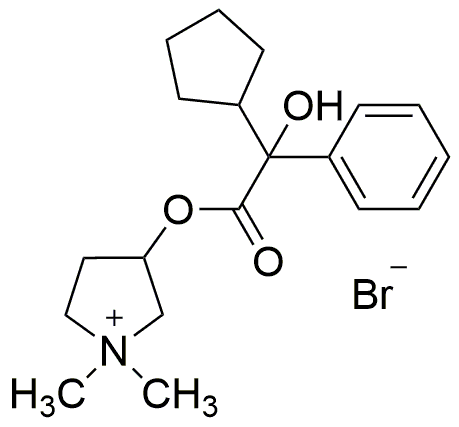Glycopyrrolate is widely utilized in research focused on:
- Medical Applications: It is commonly used as an anticholinergic agent to reduce salivation and secretions during surgical procedures, enhancing patient comfort and safety.
- Respiratory Therapy: This compound is effective in treating chronic obstructive pulmonary disease (COPD) by helping to open airways, making it easier for patients to breathe.
- Gastrointestinal Disorders: Glycopyrrolate is used to manage conditions like peptic ulcers and irritable bowel syndrome (IBS) by decreasing gastric acid secretion and intestinal motility.
- Neuromuscular Blockade Reversal: In anesthesia, it serves as an adjunct to reverse the effects of neuromuscular blockers, aiding in quicker recovery post-surgery.
- Research and Development: It is also a valuable tool in pharmacological studies, helping researchers understand the effects of anticholinergic drugs on various physiological systems.
General Information
Properties
Safety and Regulations
Applications
Glycopyrrolate is widely utilized in research focused on:
- Medical Applications: It is commonly used as an anticholinergic agent to reduce salivation and secretions during surgical procedures, enhancing patient comfort and safety.
- Respiratory Therapy: This compound is effective in treating chronic obstructive pulmonary disease (COPD) by helping to open airways, making it easier for patients to breathe.
- Gastrointestinal Disorders: Glycopyrrolate is used to manage conditions like peptic ulcers and irritable bowel syndrome (IBS) by decreasing gastric acid secretion and intestinal motility.
- Neuromuscular Blockade Reversal: In anesthesia, it serves as an adjunct to reverse the effects of neuromuscular blockers, aiding in quicker recovery post-surgery.
- Research and Development: It is also a valuable tool in pharmacological studies, helping researchers understand the effects of anticholinergic drugs on various physiological systems.
Documents
Safety Data Sheets (SDS)
The SDS provides comprehensive safety information on handling, storage, and disposal of the product.
Product Specification (PS)
The PS provides a comprehensive breakdown of the product’s properties, including chemical composition, physical state, purity, and storage requirements. It also details acceptable quality ranges and the product's intended applications.
Certificates of Analysis (COA)
Search for Certificates of Analysis (COA) by entering the products Lot Number. Lot and Batch Numbers can be found on a product’s label following the words ‘Lot’ or ‘Batch’.
Numéro de catalogue
Numéro de lot/série
Certificates Of Origin (COO)
This COO confirms the country where the product was manufactured, and also details the materials and components used in it and whether it is derived from natural, synthetic, or other specific sources. This certificate may be required for customs, trade, and regulatory compliance.
Numéro de catalogue
Numéro de lot/série
Safety Data Sheets (SDS)
The SDS provides comprehensive safety information on handling, storage, and disposal of the product.
DownloadProduct Specification (PS)
The PS provides a comprehensive breakdown of the product’s properties, including chemical composition, physical state, purity, and storage requirements. It also details acceptable quality ranges and the product's intended applications.
DownloadCertificates of Analysis (COA)
Search for Certificates of Analysis (COA) by entering the products Lot Number. Lot and Batch Numbers can be found on a product’s label following the words ‘Lot’ or ‘Batch’.
Numéro de catalogue
Numéro de lot/série
Certificates Of Origin (COO)
This COO confirms the country where the product was manufactured, and also details the materials and components used in it and whether it is derived from natural, synthetic, or other specific sources. This certificate may be required for customs, trade, and regulatory compliance.


